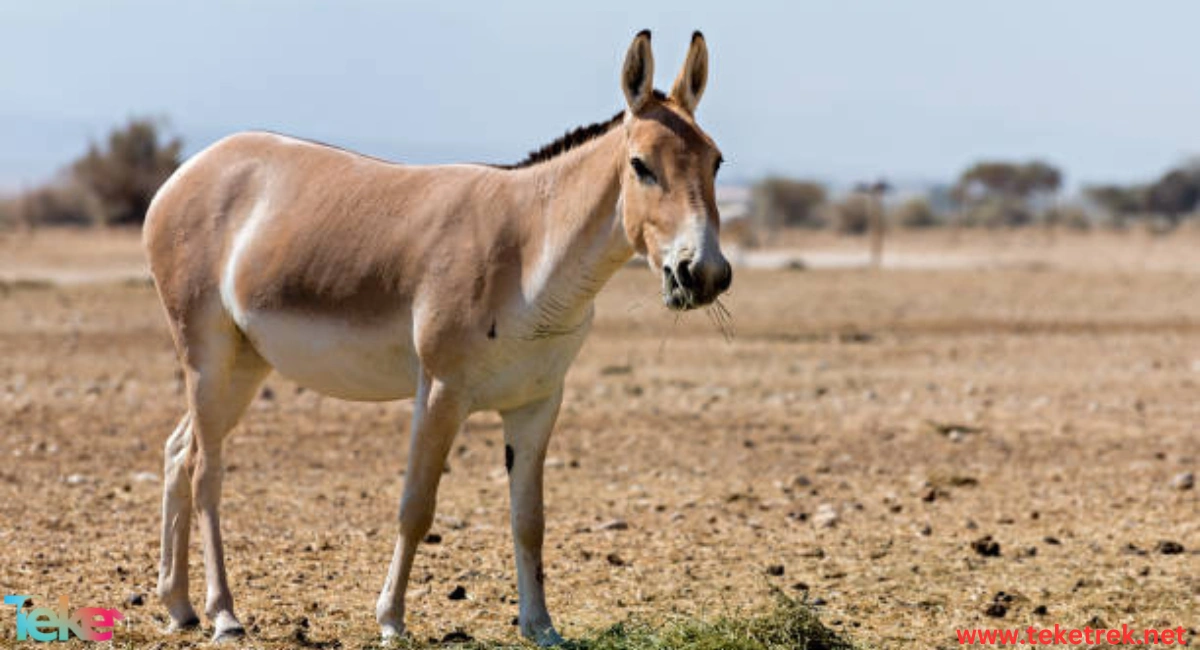It belongs to the equid family, equus genus, and order perissodactyla, It also known as Equus hemionus or Pallas,
Let’s learn more about it from teketrek.
The Asian wild ass specification
The Color: It has a reddish-brown coat in summer and a yellowish-brown coat in winter. The belly, rump, and muzzle are white.
It has a thick black stripe on its back with white edges, except for the Mongolian wild ass, which has a black stripe along its spine.
The limbs: It has relatively short limbs without stripes.
The hooves, the tail: The hooves are small, and the tail ends with a tuft of hair that stands erect on the neck.

The Asian Wild Ass subspecies
There are five subspecies of the Asian wild ass, including:
the Indian wild ass, Persian onager, Turkmenian kulan, and Mongolian wild ass.
Facts about The Asian Wild Ass
Asian wild asses graze on a low-protein and fiber-rich diet throughout the day.
They enjoy the company of other donkeys and often form bonds with them.
When not available, they may associate with horses and mules.
Although they are known for their stubbornness, it is for self-preservation, which makes it difficult to force a donkey to do something dangerous. Their body language is also less expressive than that of horses, making it difficult to read.
The Asian wild ass is slower than horses but is sturdy and strong.
Historians believe that the domestication of donkeys helped spread the cultures of ancient herders around the world.
Due to their social and calm nature, Asian wild asses can coexist well with other domesticated mammals and can also be excellent companions for people with physical or mental disabilities.
What is the onager habitat
Asian wild asses live in mountainous deserts, semi-desert regions, and desert plains.
Currently, their presence is mainly restricted to semi-desert and desert areas.
They used to be abundant in the northern Jordanian desert, part of the Badia region known as Badiyat Al-Sham, which stretches between Jordan and Syria.
However, in the early 20th century, they faced intense hunting and persecution in Jordan and Syria, leading to their extinction in these areas.
What is the diet of the Asian wild ass
The Asian wild ass is a herbivore and feeds on plants and wild grasses, including forbs, shrubs, and tender thorny shoots.
It is known to tolerate living in harsh natural conditions.
The Asian wild ass primarily relies on grazing during the dry season and in drier habitats, supplementing its diet with shrubs.
The Asian wild ass is capable of going without water for a period ranging from two to four days, depending on the surrounding temperature and the moisture content in the forage it consumes.
Access to water is a crucial factor for them, especially during the summer months.
Reproduction stages of the Asian wild ass
The breeding season for the Asian wild ass occurs between April and October, and the gestation period for a female Asian wild ass is approximately 340 to 365 days.
They have a single offspring per pregnancy, and females give birth to one foal.
Sexual maturity is reached at around 24 to 48 months.

FAQs about the Asian wild ass
What are the main predators of the Asian wild ass?
In the wild, predators include foxes, wolves, and lions.
How long does the Asian wild ass live?
The average lifespan of a donkey is 25-30 years, but they can live longer.
The oldest recorded donkey was a female domesticated donkey in the United States that lived for 54 years.
What is the usefulness of the Asian wild ass?
In developed countries, their use as working animals has diminished. Donkeys are used to produce mules, guard sheep, provide donkey rides for children or tourists, and serve as pets.
They can be grazed or tethered with horses and mules, and they are believed to have a calming effect on nervous horses.
Is the Asian wild ass intelligent?
They have exceptional intelligence, with remarkable memories.
What is the common name of Equus hemionus?
The Asiatic wild ass (Equus hemionus) or locally referred to as Gobi khulan, Turkmen kulan, Persian onager and Indian khuraffectionate.
In conclusion, it is important to highlight the significance of this animal and its contribution to environmental balance.
References:





